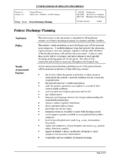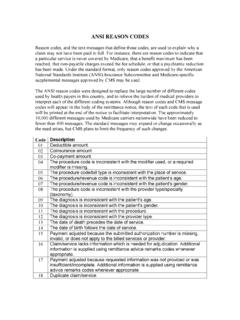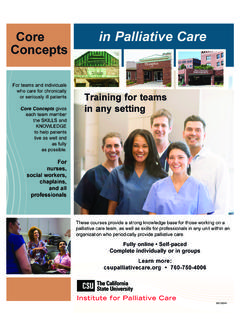Transcription of SIMULATING VISION LOSS: WHAT LEVELS OF …
1 SIMULATING VISION loss : what LEVELS OF impairment ARE actually represented ? Joy Goodman-Deane, Sam Waller, Alice-Catherine Collins, John Clarkson Engineering Design Centre, Engineering Department University of Cambridge Cambridge CB2 1PZ, UK Capability loss simulators give designers a brief experience of some of the functional effects of capability loss . They are an effective method of helping people to understand the impact of capability loss on product use. However, it is also important that designers know what LEVELS of loss are being simulated and how they relate to the user population. The study in this paper tested the Cambridge Simulation Glasses with 25 participants to determine the effect of different numbers of glasses on a person s visual acuity.
2 This data is also related to the glasses use in usability assessment. A procedure is described for determining the number of simulator glasses with which the visual detail on a product is just visible. This paper then explains how to calculate the proportion of the UK population who would be unable to distinguish that detail. Introduction As the population of the developed world ages, there is a growing awareness of the need for more accessible and inclusive designs. Products and services need to be usable by people with a wider range of capabilities and characteristics. To do this, designers need more and better information about people s capabilities and capability loss and their impact on usability.
3 However, written methods of presenting such information can often seem dry and difficult to relate to real-life product use. An alternative is the use of capability loss simulators. These simulators give designers and other stakeholders a brief experience of some of the functional effects of capability loss for themselves (Nicolle and Maguire, 2003; Cardoso and Clarkson, 2006). A functional effect is the effect of a medical or other condition on a person s physical or sensory capabilities, such as the ability to see fine detail. Thus simulation can be achieved through wearing equipment that restricts one s motion or reduces one s sensory capability. This ranges from whole body suits such as the Third-Age Suit (Hitchcock et al.)
4 , 2001) to individual sets of gloves or glasses ( Goodman-Deane et al, 2008). Some authors also advocate using simple techniques to reduce capability in a rougher, more approximate manner, such as taping buttons onto knuckles or smearing glasses with petroleum jelly (Nicolle and Maguire, 2003). Alternatively, simulation software can be used to show how things would appear or sound to someone with a sensory impairment ( Goodman-Deane et al, 2008). Simulators can encourage greater empathy with users with capability loss , and provide a more personal understanding of impairment . Designers can also wear simulators while using products and prototypes to give them some insight into the effect of capability loss on product use and to identify usability problems.
5 Simulation does have limitations, as it provides a constrained experience of capability loss . It does not convey the frustration, social consequences or coping strategies involved in living with an impairment day-to-day. It is also usually not possible (or not ethical) to simulate the pain and other symptoms associated with an impairment . As a result, simulation is not intended to be used on its own. Rather, it should be used in combination with user involvement and expert appraisal methods. It can supplement these by helping a designer to internalize information obtained through other methods. It can also provide initial usability feedback to help correct some of the major issues before designs are taken to users.
6 Calibrating simulators Another limitation of simulation is that it is often difficult for designers to tell what LEVELS of impairment simulations correspond to, and thus whether they affect many of the target user group or just a few. This is particularly problematic for the rough-and-ready simulation techniques, but can also affect pre-produced simulators. For example, the Third-Age Suit reduced visual acuity, increased glare sensitivity and added a yellow tint, to simulate some of the effects of aging on VISION . However, it did not specify what level of these effects were used (Hitchcock et al., 2001). Other simulators do cover a range of impairment . This is particularly common with software simulation where LEVELS of VISION or hearing loss can often be manipulated through interface controls ( eclipse, 2012).
7 However, software simulators lack the immediacy and immersiveness of wearable simulators or their ability to be used while examining products directly. Wearable simulators can also cover a range of capability loss . In VISION simulation, sets often contain multiple pairs of glasses that mimic different LEVELS of VISION loss ( Zimmerman Low VISION Simulation Kit, 2012). However, these are often designed for education purposes and thus only cover higher LEVELS of impairment , with simulated VISION typically starting at about 20/60 or worse (affecting less than of the population). They thus do not help designers to understand the lower LEVELS of impairment that can cause many people problems with mainstream designs.
8 Furthermore, the basis for stating that a certain pair of glasses simulates a certain level of impairment is also often unclear. This study address this issue by calibrating the level of visual acuity loss simulated by a set of simulator glasses covering both lower and higher LEVELS of VISION impairment (Engineering Design Centre, 2011). Waller et al (2008) calibrated an earlier version of these glasses using a self-report VISION capability scale. Their purpose was to demonstrate how such data could be presented and used, rather than to give an accurate calibration. The current study takes this further, using a standard VISION test with 25 participants to give more reliable data, and comparing the results with data on visual acuity in the wider population.
9 The Cambridge Simulation Glasses The study used the Cambridge Simulation Glasses, which restrict the ability to see fine detail and perceive contrast differences (Engineering Design Centre, 2011). The glasses are made from a thin, lightweight material so they can be layered to simulate greater LEVELS of impairment (Figure 1). Gloves are also available that restrict the functional ability of the hands. The two can be used in combination to help designers understand the impact of a range and combination of impairments. Figure 1: Cambridge simulation glasses The glasses and gloves were developed from a previous toolkit by Cardoso and Clarkson (2006), which was adapted by Waller et al (2008).
10 The glasses in this paper were further developed to make them cheaper to manufacture and to make it easier to wear multiple pairs on top of each other. The glasses examined in this study were the Level 2 glasses from the kit, which contain two sheets of filter material. Level 1 pairs, containing a single sheet, were not available at the time of the study. Furthermore, using Level 2 glasses meant that the range of the glasses could be examined while keeping the length of the study manageable. Calibration of the simulators Method Participants visual acuity (VA) was measured using the Landolt C chart from Test Chart 2000, with 8 possible orientations of the C. This eye test is a standardised and reliable method of measuring visual acuity.






